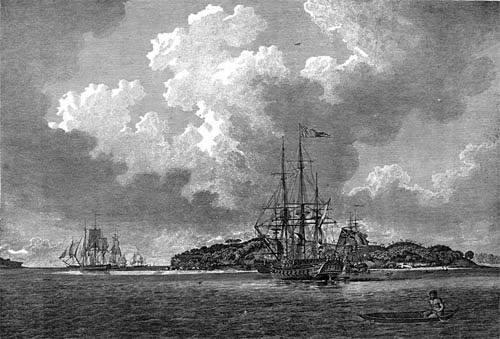Alexander (1783 ship) facts for kids
Quick facts for kids History |
|
|---|---|
| Name | Alexander |
| Owner | Walton & Company |
| Port of registry | Hull |
| Builder | Walton & Company, Hull |
| Launched | 1783, or 1784 |
| Fate | Lost c.1809 |
| General characteristics | |
| Tons burthen | 44485⁄94, 452, or 468 |
| Length | 114 ft (35 m) |
| Beam | 31 ft (9.4 m) |
| Sail plan | Ship rig; later barque |
| Complement | 40 |
| Armament |
|
The Alexander was a large merchant ship built in Hull, England, around 1783 or 1784. She became famous as one of the ships in the First Fleet. This fleet was a group of ships the British government used to transport people to start a new colony in Australia in 1788.
After her journey to Australia, the Alexander was allowed by the British East India Company to carry goods from Canton (now Guangzhou, China) back to Britain. She continued to trade from London until about 1809, when she was no longer listed in shipping records.
Contents
Building the Alexander
The Alexander was built as a barque, a type of sailing ship with three masts. She was quite plain, without fancy decorations or a figurehead at the front. At 452 tons, she was the biggest transport ship in the First Fleet. She usually had a crew of at least 30 sailors.
The ship was owned by Walton & Company, a group of merchants from Southwark, England. The main person in charge of the ship, known as her master, was Duncan Sinclair.
The First Fleet Journey
Getting Ready for Australia
In early 1787, the Alexander began loading people at Woolwich Docks. These people were being sent to Australia. Some came from prison ships on the River Thames, and others directly from Newgate Prison. The Alexander then sailed to Portsmouth to join the rest of the First Fleet.
Before the Alexander left Portsmouth, many people on board became very sick with a fever. Sadly, 16 men died. The ship left Portsmouth on May 13, 1787, carrying 195 men. During the long journey, 15 more people died, which was the highest number for any ship in the fleet.
The sickness was likely caused by dirty water in the bottom of the ship, called the bilge. A surgeon named John White described how bad the smell was. He said the air was so foul it turned things black. After complaints, the ship's bilge was pumped regularly. This helped the health of the people on board get much better.
Arriving in Australia
After sailing past Tasmania, the fleet's leader, Arthur Phillip, moved to a faster ship called Supply. He went ahead with three quick transport ships, including the Alexander. They were the first to reach Botany Bay on January 18 and 19, 1788.
However, the leaders decided that Botany Bay was not the best place for the new colony. So, the Alexander sailed to Port Jackson, which is now Sydney, Australia. She arrived there on January 26, 1788, to unload her passengers.
While in Port Jackson, a man named Henry Kable, who had been transported, successfully sued the ship's master, Duncan Sinclair. Henry Kable said his belongings were lost during the voyage. This was the first civil court case in Australia, and Henry Kable won 15 pounds.
The Journey Back to England
The British East India Company had arranged for the Alexander to carry tea from Canton (China) after she dropped off her passengers. She left Port Jackson on July 14, 1788, sailing with another ship called Friendship. The Alexander picked up the crew of the Friendship when that ship was sunk on purpose in Batavia (now Jakarta, Indonesia) on its way to Canton.
The Alexander arrived back in the River Thames in England on June 1, 1789. On her way back, the Alexander carried the last papers of a French explorer named Lapérouse. His expedition's ships had likely been shipwrecked in the Solomon Islands.
Later Journeys
After returning from Australia, the Alexander continued to be a merchant ship. She sailed to places like Dominica in the Caribbean and Petersburg (now St. Petersburg) in Russia. She was also used as a transport ship, carrying goods for London.
What Happened to the Alexander?
The Alexander was still listed in shipping records in 1810. However, next to her name, there was a note saying "LOST." This means the ship was lost at sea or no longer in service around that time.
Remembering the Alexander
In 1985, a ferry in Sydney, Australia, was named after the Alexander. This ferry is part of a special group of ferries named after the ships of the First Fleet.
Notable Passengers
- John Caesar: He was one of the earliest people of African descent to settle in Australia. He later became a well-known bushranger, which was like an outlaw in the Australian wilderness.
See Also
- Journals of the First Fleet
- List of convicts on the First Fleet


